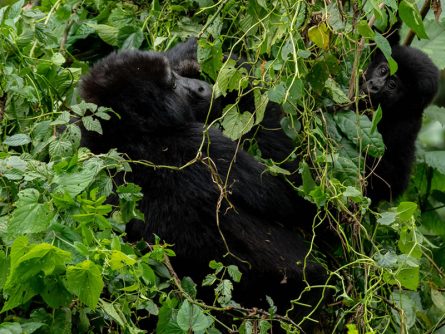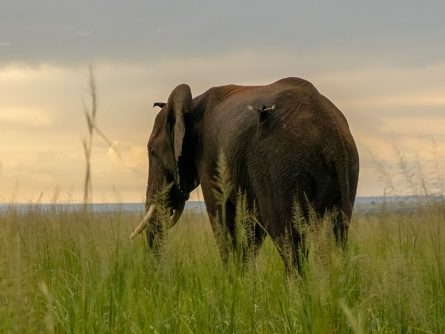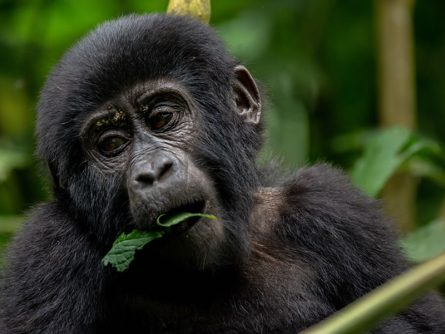Semuliki National Park is a gem tucked away in the western part of Uganda, bordering the Democratic Republic of Congo. It is renowned for its unique biodiversity, rich culture, and diverse ecosystems.
Semuliki National Park, established in 1993, is located in the Albertine Rift Valley, covering an area of approximately 220 square kilometers. The park is part of the western arm of the East African Rift System and features a mix of tropical rainforest, savanna, and wetlands, making it a haven for a wide variety of wildlife and plant species.

ACTIVITIES IN SEMULIKI NATIONAL PARK
- Wildlife Viewing in Semuliki National Park
Wildlife viewing in Semuliki National Park is a unique and rewarding experience, offering visitors the chance to explore one of Uganda’s most biodiverse and least disturbed natural environments. Nestled in the Albertine Rift Valley, this park is a hidden gem that boasts a rich variety of wildlife, much of which is more commonly associated with the Central African rainforests than with East Africa.
A Diverse Array of Mammals
Semuliki National Park is home to over 60 mammal species, making it an excellent destination for wildlife enthusiasts. The park’s mix of lowland tropical rainforest, swamps, and grasslands creates habitats for a wide range of animals. Among the notable species you might encounter are:
Forest Elephants: Smaller than their savannah counterparts, these elusive elephants roam the dense forests of Semuliki, often leaving behind signs such as footprints and broken branches. Sightings are rare, but their presence adds an element of excitement to wildlife viewing.
Pygmy Hippopotamus: An incredibly rare and shy species, the pygmy hippo is occasionally spotted along the Semuliki River and in the park’s swampy areas. These nocturnal animals are challenging to observe, but the possibility of encountering one makes wildlife viewing in the park even more thrilling.
Buffaloes: The forest buffaloes in Semuliki are smaller and darker than the savannah buffaloes found elsewhere in Uganda. They can often be seen grazing in the clearings and along the edges of the forest.
Primates: The park is a primate haven, with several species making their home in its lush forests. Visitors can spot chimpanzees, olive baboons, black-and-white colobus monkeys, red-tailed monkeys, and the rare De Brazza’s monkey. The playful and curious nature of these primates often leads to memorable encounters.
Leopards: Although elusive and primarily nocturnal, leopards are known to inhabit the park’s forests. Sightings are infrequent, but the chance to see one adds a sense of adventure to any wildlife viewing excursion.
Civets and Genets: These small, nocturnal carnivores are occasionally seen during night drives or at dusk, adding to the diversity of the park’s wildlife.
Birds and Reptiles
In addition to mammals, Semuliki National Park is a paradise for bird watchers, with over 440 bird species, many of which are endemic to the Albertine Rift. The park is also home to a variety of reptiles, including crocodiles that inhabit the Semuliki River, and various species of snakes and lizards.
One of the key attractions of wildlife viewing in Semuliki National Park is the variety of habitats you can explore. The park’s diverse landscapes include:
- Tropical Rainforest: The dense forest is home to many of the park’s primates, as well as forest elephants and a variety of bird species.
- Swamps and Marshlands: These areas provide habitats for the pygmy hippo, crocodiles, and several bird species, including the elusive shoebill stork.
- Savannah Grasslands: Open areas where buffaloes and other herbivores can be seen grazing.
The different ecosystems within the park ensure that visitors have the opportunity to encounter a wide range of species during their visit.
Sempaya Hot Springs: A Wildlife Hotspot
The Sempaya Hot Springs, one of the park’s most famous attractions, also serve as a hotspot for wildlife viewing. The surrounding area attracts various animals, including monkeys, forest elephants, and numerous bird species. The springs are also an excellent place to observe butterflies, which are attracted to the mineral-rich soil.
Why you should visit Semuliki National Park?
Semuliki National Park offers a unique wildlife viewing experience, distinct from other parks in Uganda. Its Central African-influenced biodiversity, combined with its remote and pristine environment, provides a rare glimpse into a world where nature thrives largely undisturbed. Whether you’re hoping to spot rare mammals, encounter playful primates, or simply immerse yourself in a truly wild landscape, wildlife viewing in Semuliki is an adventure that promises both excitement and tranquility.
- Bird Watching in Semuliki National Park
Bird watching in Semuliki National Park is a captivating experience for both avid birders and nature enthusiasts. Located in the Albertine Rift Valley, this park is one of Uganda’s most important birding destinations, boasting an extraordinary diversity of bird species due to its unique position at the crossroads of East African savannah and the Central African rainforest.
A Birding Haven
Semuliki National Park is home to over 440 bird species, many of which are rare and endemic to the region. The park's diverse habitats, including lowland tropical forests, swampy areas, and savannah, create the perfect environment for a wide variety of birds. This makes it one of the richest areas in Uganda for birding, with species that are not commonly found in other parts of the country.
Key Bird Species In Semuliki National Park
Bird watchers in Semuliki can look forward to encountering several sought-after species. Some of the key species include:
Nkulengu Rail: This elusive bird is more easily heard than seen, but Semuliki is one of the few places where it can be spotted.
Shoebill Stork: Although rare, the park’s swampy areas provide a habitat for this iconic and prehistoric-looking bird.
African Piculet: A diminutive woodpecker that is a prized find for birders.
White-crested Hornbill: Known for its striking appearance, this hornbill is a highlight for bird watchers.
Red-billed Dwarf Hornbill: Another unique hornbill species that adds to the diversity of hornbills in the park.
Yellow-throated Nicator: A brightly colored bird often seen flitting through the forest canopy.
Long-tailed Hawk: A stunning raptor with a strikingly long tail, often seen soaring above the forest.
Lyre-tailed Honeyguide: Known for its melodious song and distinctive tail feathers.
Congo Serpent Eagle:A rare and elusive bird of prey that adds to the excitement of birding in Semuliki.
These are just a few of the remarkable species that birders can encounter during their visit. The park’s proximity to the Congo Basin means that it hosts several species that are more commonly found in Central Africa, making it a unique birding destination in Uganda.
Best Birding Spots in Semuliki National Park
Some of the best birding spots in Semuliki National Park include the Sempaya Hot Springs area, the Kirumia Trail, and the forests along the Semuliki River. Each of these locations offers different habitats, increasing the chances of seeing a wide range of species. The Sempaya area, in particular, is known for its mix of forest and swamp birds, while the Kirumia Trail offers a deeper immersion into the forest, with opportunities to see more elusive species.
Why Bird Watch in Semuliki National Park?
Semuliki National Park offers a truly exceptional birding experience due to its rich avifauna and the chance to see species that are difficult to find elsewhere in Uganda. The park’s remote and pristine environment adds to the allure, providing a serene and undisturbed setting for birding. Whether you are a seasoned birder looking to tick off rare species from your list or a nature lover eager to explore one of Uganda’s most biodiverse parks, bird watching in Semuliki is an unforgettable experience.
- Nature Walks in Semuliki National Park
Nature walks in Semuliki National Park offer an intimate and immersive way to experience the park's rich biodiversity and unique landscapes. Situated in the western part of Uganda, this park is a hidden gem known for its diverse ecosystems that range from tropical rainforests to savannah grasslands.
What to Expect during nature walks in Semuliki National Park
During a nature walk in Semuliki National Park, visitors can explore the lush forests, where they will be surrounded by towering trees, ferns, and a variety of plant species. The walks are guided by experienced park rangers who are knowledgeable about the flora and fauna of the area. These rangers not only ensure your safety but also provide fascinating insights into the park's natural history.
- Wildlife Encounters
As you traverse the trails, there are opportunities to spot various wildlife species. Semuliki is home to several primates, including the black-and-white colobus monkeys, grey-cheeked mangabeys, and red-tailed monkeys. Bird watchers will be thrilled by the park's rich avian diversity, with over 400 bird species recorded, including the rare and elusive shoebill stork. The nature walk also presents a chance to see smaller mammals, butterflies, and insects that thrive in this unique environment.
- Sempaya Hot Springs
One of the highlights of the nature walk is a visit to the famous Sempaya Hot Springs. These geothermal springs are a significant attraction in the park, with two main springs: the male spring, known as "Bintente," and the female spring, "Nyasimbi." The female spring is particularly fascinating due to its boiling geyser, which spouts water up to two meters high. Visitors can witness the local tradition of boiling eggs and bananas in the hot spring water—a simple yet memorable experience that connects you to the natural wonders of Semuliki.
- Cultural Encounters
The nature walk also offers a cultural dimension, as the park is home to the Batwa pygmies, one of Africa's oldest indigenous tribes. Visitors may have the opportunity to learn about the Batwa’s traditional way of life, their relationship with the forest, and their cultural practices. This adds a rich layer to the experience, making the walk not just about nature, but also about understanding the deep cultural ties the local communities have with the environment.
- Cultural Encounters in Semuliki National Park
Cultural experiences in Semuliki National Park offer visitors a unique opportunity to engage with the indigenous communities that have lived in harmony with the park’s rich natural environment for centuries. Located in Uganda’s western region, the park is not only a haven for wildlife and bird species but also a cultural crossroads, where ancient traditions and ways of life are preserved and practiced by local communities.
- Batwa People: Guardians of the Forest
One of the most significant cultural experiences in Semuliki National Park is the chance to meet and learn from the Batwa people, often referred to as the “Keepers of the Forest.” The Batwa are one of Africa’s oldest indigenous tribes, with a history deeply rooted in the forests of Central Africa. For generations, they have lived as hunter-gatherers, relying on the forest for food, shelter, and medicine.
Visitors to Semuliki can embark on a guided cultural tour that takes them into Batwa communities, where they can experience firsthand the Batwa’s traditional way of life. During these encounters, the Batwa share their knowledge of the forest, demonstrating how they use various plants for medicinal purposes, fire-making, and crafting tools. The Batwa are also known for their rich oral traditions, and visitors may have the opportunity to listen to ancient stories, songs, and dances that have been passed down through generations.
- Traditional Healing Practices
A highlight of the cultural experience in Semuliki is learning about the traditional healing practices of the local communities. The Bamba and Bakonzo people, who also reside around the park, are known for their deep knowledge of herbal medicine. On a cultural tour, visitors can meet local herbalists who use plants from the forest to create remedies for various ailments. These herbalists often share their expertise on the medicinal properties of different plants and how they are prepared and used in healing rituals.
- Sempaya Hot Springs: A Spiritual Site
The Sempaya Hot Springs are not only a natural wonder but also hold cultural and spiritual significance for the local communities. The hot springs are considered sacred by the Batwa, Bamba, and Bakonzo people, who believe they are inhabited by powerful spirits. Local legends tell stories of the origins of the springs, and visitors may hear these tales during a cultural visit.
The springs have traditionally been used for spiritual cleansing, and some locals still visit the springs for ritual purposes. Witnessing or participating in a traditional ceremony at the hot springs can be a profound cultural experience, offering insight into the spiritual beliefs that connect the people to the land.
- Cultural Artifacts and Crafts
Visitors to Semuliki National Park also have the opportunity to explore and purchase traditional crafts made by the local communities. The Batwa, Bamba, and Bakonzo are skilled artisans, creating beautiful handcrafts such as baskets, pottery, and woven mats. These items are often made using materials sourced from the forest, and purchasing them provides direct support to the local economy while offering a meaningful memento of your visit.
Why Engage in Cultural Activities in Semuliki National Park?
Cultural activities in Semuliki National Park provide a deeper understanding of the relationship between the local communities and the natural environment. These encounters allow visitors to appreciate not only the park's biodiversity but also the cultural heritage that has been shaped by and intertwined with the forest for generations. Engaging with the Batwa and other local groups offers a unique perspective on sustainable living, resilience, and the importance of preserving both cultural and natural landscapes.
For travelers interested in cultural tourism, a visit to Semuliki National Park is an enriching experience that goes beyond wildlife and scenery, offering an authentic connection to the people who have called this area home for millennia.
Photography and Scenic Viewing in Semuliki National Park
Photography and scenic viewing in Semuliki National Park offer an unparalleled opportunity to capture the raw beauty of one of Uganda’s most biodiverse and visually striking landscapes. Nestled in the Albertine Rift Valley, this park provides a stunning backdrop for photographers and nature lovers alike, with its mix of tropical rainforests, hot springs, rivers, and expansive savannahs.
A Photographer’s Paradise
Semuliki National Park is a treasure trove for photographers, offering a diverse range of subjects that include wildlife, landscapes, and cultural experiences. Whether you’re an amateur with a smartphone or a seasoned professional with a DSLR, the park provides endless opportunities to create memorable images.
Wildlife Photography
The park’s rich biodiversity makes it a prime location for wildlife photography. From elusive forest elephants and playful primates to vibrant bird species and rare mammals like the pygmy hippo, there’s no shortage of subjects. The dense tropical forests create a mystical atmosphere, where shafts of sunlight filter through the canopy, illuminating your subjects in a soft, natural light that’s perfect for capturing stunning wildlife portraits.
Key areas for wildlife photography include:
- The Kirumia Trail: This trail winds through the heart of the forest, offering chances to photograph primates, birds, and the lush greenery.
- The Semuliki River: A picturesque location where you might capture images of crocodiles, hippos, and birds in their natural habitat.
- Sempaya Hot Springs: The hot springs attract various animals, making it a hotspot for wildlife photography.
Landscape Photography
Semuliki National Park’s landscapes are as diverse as its wildlife. The park is situated in a valley surrounded by the Rwenzori Mountains to the southeast and the Congo Basin’s lowlands to the west, creating a dramatic setting that’s perfect for landscape photography.
Some of the park’s most photogenic spots include:
- The Sempaya Hot Springs: These geothermal features are not only fascinating natural wonders but also provide a striking contrast to the surrounding forest. The steam rising from the springs, especially in the early morning or late afternoon light, creates a mystical and surreal scene.
- The Semuliki River: This river winds through the park, offering serene and reflective scenes, especially during sunrise and sunset. The river’s calm waters mirror the surrounding vegetation, providing perfect opportunities for tranquil, mirror-like shots.
- Panoramic Views of the Albertine Rift: The park’s location within the Albertine Rift Valley offers breathtaking panoramic views, particularly from higher elevations. Photographers can capture the vastness of the landscape, with rolling hills, dense forests, and the distant peaks of the Rwenzori Mountains.
Cultural Photography
In addition to natural scenery, Semuliki National Park offers cultural photography opportunities. The Batwa people, indigenous to the region, have a rich cultural heritage that is visually captivating. Photographing their traditional dances, crafts, and daily activities provides an authentic glimpse into their way of life, adding a human element to your portfolio.
Scenic Viewing in Semuliki National Park
For those who simply want to soak in the beauty of Semuliki without the camera, the park offers numerous scenic viewpoints and trails that allow visitors to fully appreciate the natural surroundings.
- Sempaya Hot Springs: The viewing area around the hot springs offers stunning vistas of the springs themselves, as well as the surrounding forest. The springs are especially beautiful in the early morning when the mist adds an ethereal quality to the scene.
- Riverine Views: The banks of the Semuliki River provide peaceful spots where visitors can enjoy the sights and sounds of the water, watching for wildlife that frequents the area.
- Forest Canopy: Walking through the park’s dense rainforest allows visitors to experience the towering trees, lush undergrowth, and the symphony of bird calls. The forest itself is a scenic wonder, with its rich greenery and diverse plant life.
Best Times for Photography and Viewing in Semuliki National Park
The best times for photography and scenic viewing in Semuliki National Park are during the early morning and late afternoon. The soft, golden light during these hours enhances the natural beauty of the landscapes and wildlife, making it ideal for photography. Additionally, the cooler temperatures and the active movement of animals during these times increase the chances of capturing dynamic and engaging shots.
Why Engage in Photography and Scenic Viewing at Semuliki National Park
Semuliki National Park is a photographer’s dream, offering a wealth of natural beauty and biodiversity that few places can match. The park’s combination of rare wildlife, dramatic landscapes, and cultural richness provides a perfect canvas for photographers and nature lovers alike. Whether you’re looking to capture the perfect shot or simply enjoy the breathtaking views, Semuliki’s untouched wilderness promises an unforgettable experience.
Accommodation in Semuliki National Park
When visiting Semuliki National Park, choosing the right accommodation is key to fully enjoying your experience in this remote and biodiverse region of Uganda. While the park is relatively off the beaten path, it offers a selection of accommodation options that cater to different budgets and preferences, all designed to provide comfort while allowing you to immerse yourself in the natural beauty of the area.
- Luxury Lodges
For those seeking a more luxurious stay, Semuliki National Park offers several high-end lodges that combine comfort with the thrill of being close to nature.
- Semuliki Safari Lodge:
This is the most renowned luxury lodge in the area, offering an exclusive and intimate experience. Located within the park, Semuliki Safari Lodge features spacious tented cottages with en-suite bathrooms, elegantly furnished with a blend of traditional and modern decor. Each cottage offers stunning views of the surrounding savannah and the distant Congo Mountains. The lodge provides personalized service, gourmet dining, and a range of activities, including guided game drives, nature walks, and cultural visits. The atmosphere here is serene, making it a perfect retreat for those looking to unwind in luxury while exploring the park.
- Mid-Range Accommodations
Travelers seeking a balance between comfort and affordability will find several mid-range options around Semuliki National Park. These accommodations offer cozy, well-maintained facilities with easy access to the park’s attractions.
- Ntoroko Game Lodge:
Located on the shores of Lake Albert, this lodge offers mid-range accommodation with a touch of luxury. Guests can choose between cottages and safari tents, all with en-suite bathrooms and beautiful lake views. The lodge’s proximity to the park makes it an excellent base for wildlife viewing and bird watching. The restaurant serves a variety of local and international dishes, and there is a bar where guests can relax after a day of exploration.
- Kirimia Guesthouse:
For those who prefer a simpler, more budget-friendly option, Kirimia Guesthouse offers basic but comfortable accommodation. Situated close to the Kirimia Trail, this guesthouse is ideal for bird watchers and nature enthusiasts. The rooms are clean and modest, with shared bathroom facilities. The guesthouse provides meals, and the friendly staff can help arrange guided walks and other activities in the park.
- Budget Options
For budget-conscious travelers, there are a few options that offer basic amenities at affordable rates. These accommodations are ideal for those who prioritize proximity to nature and the park’s attractions over luxury.
- Uganda Wildlife Authority (UWA) Bandas:
Located within the park, the UWA Bandas provide budget accommodation in the heart of Semuliki’s wilderness. These bandas (simple, thatched cottages) are basic but comfortable, with beds, mosquito nets, and shared bathroom facilities. Staying here allows visitors to be fully immersed in the park’s natural environment, with wildlife often seen nearby. The UWA Bandas are an excellent option for backpackers and adventurous travelers who want to experience the park’s raw beauty without breaking the bank.
- Camping:
For the ultimate budget-friendly and immersive experience, camping is available at designated sites within the park. The campgrounds are managed by the Uganda Wildlife Authority and offer basic facilities such as pit latrines and water sources. Campers need to bring their own tents and camping gear. Camping in Semuliki allows you to be completely surrounded by nature, with the sounds of the forest as your nightly backdrop. It’s an adventurous option for those who want to experience the park in its most authentic form.
Why Stay in Semuliki?
Staying within or near Semuliki National Park enhances your overall experience, allowing you to fully engage with the park’s unique wildlife, landscapes, and cultural heritage. Whether you’re looking for luxury, comfort, or a budget-friendly stay, the accommodations in and around Semuliki offer something for every type of traveler. By choosing to stay close to the park, you maximize your time exploring its many attractions, from wildlife viewing and bird watching to cultural encounters and scenic photography.
Whether you prefer the luxury of a safari lodge, the comfort of a mid-range hotel, or the adventure of camping under the stars, Semuliki National Park’s accommodations provide the perfect base for your Ugandan wilderness adventure.
Practical Information about Semuliki National Park
Access and Transportation: The park is accessible from Fort Portal, which is about a 2-hour drive away. There are regular bus services and private transport options available from Kampala to Fort Portal. From there, visitors can use local transport or arrange for park services to reach Semuliki.
Accommodation: The park has a range of accommodation options, including budget and mid-range lodges. Options such as the Semuliki Safari Lodge offer comfortable stays with proximity to the park’s attractions.
Best Time to Visit: The dry season from June to September and December to February is generally the best time to visit, as the weather is more favorable for wildlife viewing and outdoor activities. However, the park is accessible year-round.
Park Fees: Entrance fees and activity costs are subject to change, so it’s advisable to check with the Uganda Wildlife Authority or local tour operators for the latest information.
Semuliki National Park offers a blend of natural beauty, cultural richness, and unique wildlife experiences, making it a compelling destination for those seeking an off-the-beaten-path adventure in Uganda.






